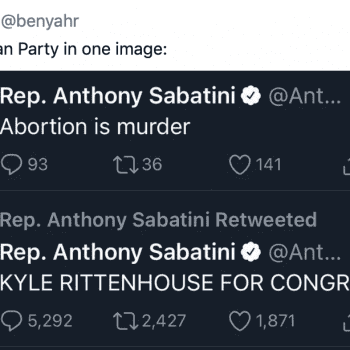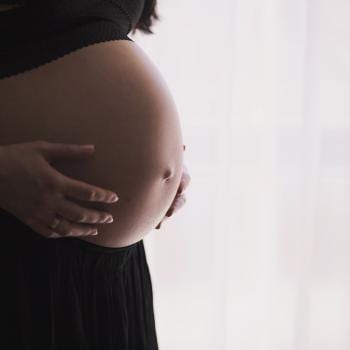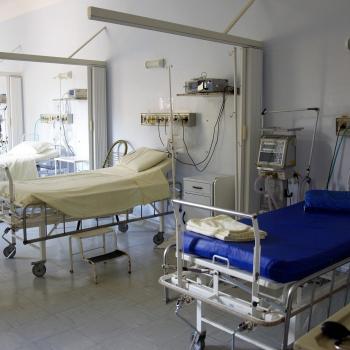I swore I wasn’t going to write about Savita again today, but it seems I can’t avoid it. I had thought until today that Savita’s death could not have happen in the United States today, because the “right of conscience” bill put forward in the House last winter, which would have let doctors with religious objections to abortion refuse to perform an abortion even to save the life of a woman, ultimately failed. I just learned that I was wrong, and I am sitting here in a bit of shock.
I’ll never forget this; it was awful — I had one of my partners accept this patient at 19 weeks. The pregnancy was in the vagina. It was over… And so he takes this patient and transferred her to [our] tertiary medical center, which I was just livid about, and, you know, “we’re going to save the pregnancy.” So of course, I’m on call when she gets septic, and she’s septic to the point that I’m pushing pressors on labor and delivery trying to keep her blood pressure up, and I have her on a cooling blanket because she’s 106 degrees. And I needed to get everything out. And so I put the ultrasound machine on and there was still a heartbeat, and [the ethics committee] wouldn’t let me because there was still a heartbeat. This woman is dying before our eyes.
This is the testimony of a doctor working in a Catholic hospital in the United States. And it’s a case essentially exactly like Savita’s. A miscarriage in process, septicemia, and a heartbeat. Did the woman die?
I went in to examine her, and I was able to find the umbilical cord through the membranes and just snapped the umbilical cord and so that I could put the ultrasound — “Oh look. No heartbeat. Let’s go.” She was so sick she was in the [intensive care unit] for about 10 days and very nearly died… Her bleeding was so bad that the sclera, the white of her eyes, were red, filled with blood… And I said, “I just can’t do this. I can’t put myself behind this. This is not worth it to me.” That’s why I left.
The doctor cut the umbilical cord so that the heartbeat would disappear so that they could “get everything out” and give the woman the treatment needed to ultimately save her life. And still, it almost wasn’t enough. She almost died and spent ten days in the ICU.
This story and many others like it come from a study published in 2008 in the American Journal of Public Health. The study is called “When There’s a Heartbeat: Miscarriage Management in Catholic-Owned Hospitals.” Here is the abstract:
As Catholic-owned hospitals merge with or take over other facilities, they impose restrictions on reproductive health services, including abortion and contraceptive services. Our interviews with US obstetrician–gynecologists working in Catholic-owned hospitals revealed that they are also restricted in managing miscarriages.
Catholic-owned hospital ethics committees denied approval of uterine evacuation while fetal heart tones were still present, forcing physicians to delay care or transport miscarrying patients to non–Catholic-owned facilities. Some physicians intentionally violated protocol because they felt patient safety was compromised.
Although Catholic doctrine officially deems abortion permissible to preserve the life of the woman, Catholic-owned hospital ethics committees differ in their interpretation of how much health risk constitutes a threat to a woman’s life and therefore how much risk must be present before they approve the intervention.
Reread that abstract a couple of times if you need to. It’s very clear and says pretty much everything that needs to be said. Catholic hospitals in the U.S. follow Catholic doctrine in the way they practice medicine, and as part of that they generally refuse to conduct a medically necessary abortion as long as a fetal heartbeat remains – which is exactly what was done in Savita’s case. They get around the fact that they are (I think) legally required to carry out an abortion if it is necessary to save a mother’s life by engaging in philosophical conversations about exactly what actually constitutes a threat to a woman’s life, and these hospitals actually have ethical committees that make the final calls rather than doctors.
And in case anyone is wondering about just how callous the decisions regarding women’s very lives made by such committees can be, take a look at this case from 1998:
Michelle Lee knows she should not have another child. Her heart pumps so weakly and irregularly that she has waited 2 1/2 years for a new one. The strain that pregnancy puts on the body, her doctors had sternly warned her for years, might kill her.
So last month, when she discovered she had accidentally gotten pregnant, Lee, 26, faced an agonizing prospect: saving her fetus or saving herself. She loves babies. Yet, finally, she went to Louisiana State University Medical Center, the century-old hospital whose cardiologists tend to her heart, and said she wanted an abortion.
The hospital refused.
A committee of five LSU doctors concluded that Lee’s chance of dying was not greater than 50 percent. And under Louisiana law, a public hospital could not perform an abortion on Lee unless her life were endangered. They decided her case didn’t meet the test.
So Lee, now 10 weeks pregnant, was taken by ambulance to Houston yesterday for the potentially life-saving abortion. She is scheduled to undergo the procedure today at St. Luke’s Episcopal Hospital, paid for with donations from around the country.
This particular hospital was not Catholic, but in Louisiana it is against the law for any hospital that receives state funds to perform an abortion except on pregnancies that result from rape or incest or endanger a woman’s life. My point in bringing up this example is to point out the sort of decisions committees convened to determine whether a pregnancy constitutes a threat to a woman’s health sometimes make. Somehow this committee determined that because Lee’s chance of dying as a result of her pregnancy was less than 50%, they could deny her an abortion. As a woman who has successfully carried two healthy pregnancies to term, this makes me sick to my stomach.
But back to the whole Catholic hospital bit. What I read made me wonder about how Catholic hospitals in the U.S. handle ectopic pregnancies. Here is what I found:
An ectopic pregnancy is not destined to be a baby. It can never, ever grow to viability. It will, however, grow to injure the pregnant woman. So you’d think treatment shouldn’t be controversial…unless of course you want care at some Catholic hospitals.
Yes, some Catholic ethicists argue that the catholic “Directives” preclude physicians at Catholic hospitals from managing ectopic pregnancies in a way that involves direct action on the embryo. So a woman can have her whole tube removed (an unnecessary procedure that could reduce her future fertility), but she can not have the pregnancy plucked out (as is done with the standard therapy, a salpingostomy, where a small incision is made in the tube and the pregnancy removed) and she most certainly could not have the methotrexate.
How common is this practice? Well, it is pretty sad that someone had to study it. According to a study from 2011 by Foster e. al., (Womens Health Issues, 2011) some Catholic hospitals refuse to offer methotrexate (three in this study of 16 hospitals). The lack of methotrexate resulted in changes in therapy, transferring patients to other facilities, and even administering it surreptitiously. All of these expose women to unnecessary risks, expense and are, quite frankly, wrong.
Honestly, after reading about how Catholic hospitals handle women who are miscarrying, I was somewhat surprised to find that most Catholic hospitals actually do follow standard medical best practices in dealing with ectopic pregnancies, even though that involves administering a drug that directly kills the (completely nonviable) embryo. The fact remains, however, that some Catholic hospitals in the U.S. do refuse to follow best practices when it comes to ectopic pregnancies.
Anyway, back to Savita’s death, Catholics’ response, and whether or not it could occur in the U.S. Adam Lee over at Daylight Atheism wrote a blog post today about the belated response the Patheos Catholic bloggers are giving to the news of Savita’s death. Apparently they are arguing that Catholic law permitted Savita to have an abortion because it was necessary to save her life, and that the problem was that the doctors at Savita’s hospital were ignorant of Catholic law. In particular, they have suggested that the doctors should have simply delivered the seventeen week fetus and then left its life or death in God’s hands. Adam Lee’s responds as follows:
So, Catholic bloggers, I ask you: If this exception is known to you, why don’t Catholic ethics committees at church-run hospitals know about it? Why don’t theologians who teach at Catholic colleges know about it? Why don’t Catholic bishops know about it? Why don’t Catholic-dominated countries that enact church-supported laws leave this loophole open? And if you’re certain that the church’s “official” position on paper permits this exception, then why do these horror stories keep happening whenever the church has its way?
After reading these stories, Sean has made me a promise. If I am ever in need of urgent medical attention and I am either pregnant or there is any possibility that I might be pregnant and not know it, he won’t take me to a Catholic hospital. And you know what’s interesting? Sean could walk into a hospital knowing that would get the medical care he needed, regardless of his condition or disease. I, in contrast, could not. If I were to walk into a Catholic hospital pregnant, I would know that my health would take second place to questions like whether or not my fetus has a heartbeat.














